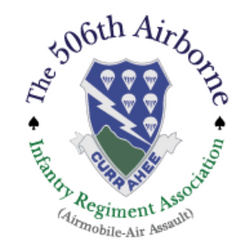distinguished service cross award recipients
Distinguished Service Cross Award Recipients
Twelve troopers of the 506th Infantry Regiment, the Currahees, received the Distinguished Service Cross for Heroism in Vietnam. As we are able to obtain award information from the National Archives read the stories of:
Troopers of the 506th Parachute Infantry Regiment, the Currahees, received the Distinguished Service Cross for Heroism during World War II in Europe. As we identify these Troopers and are able to obtain award information from the National Archives read the stories of:
| 2LT Walter G. Amerman - Co. B 506 |
| Pvt. Herman J. Cordes - Co. A 506 PIR, Normandy |
| Pfc. Gilbert Van Every - Co. D 506th PIR, Bastogne |
| Pfc. Don G. Hackman - Co. D 506 PIR, Bastogne |
| Cpl Manning G Haney - Co F 506th PIR, Randwijk Holland |
| Pfc. Orel H. Lev - Co. F 506 PIR, Holland |
| Pvt. Andrew Sosnak - Medical Detachment, Normandy |
| LTC William L. Turner - HQ 1/506 PIR, Normandy |
| Cpt. Richard D. Winters - Co. E 506 PIR, Normandy |
The Distinguished Service Cross was established by order of President Woodrow Wilson, as promulgated in War Department General Orders Number 6 of January 12, 1918, and formalized by Act of Congress on July 9, 1918 (Public Law 193, 65th Congress).
The Distinguished Service Cross has been in effect since April 6, 1917; however, under certain circumstances the Distinguished Service Cross may be awarded for services rendered prior to April 6, 1917.
Criteria
The Distinguished Service Cross may be awarded to a person who, while serving in any capacity with the Army, distinguishes himself by extraordinary heroism not justifying the award of a Medal of Honor. This extraordinary heroism must take place while the individual is engaged in an action against an enemy of the United States; or while he is engaged in military operations involving conflict with an opposing foreign force; or while he is serving with friendly foreign forces that are engaged in an armed conflict against an opposing armed force in which the United States is not a belligerent party. The act or acts of heroism must be so notable and involve risk of life so extraordinary as to set the individual apart from his comrades.
Order of Precedence
The Distinguished Service Cross is worn after the Medal of Honor and before all other decorations. Additional awards are denoted by oak leaf clusters.
Description and Symbolism of the Second (Current) Style Distinguished Service Cross
Obverse
The second style Distinguished Service Cross is a modification of the first style; it has a sculptured inner cross mounted on a flat cross with decorative, fluted edges. At the end of each arm is a small ornamental scroll topped by a ball. An eagle with displayed wings is centered on the cross and behind the eagle is a circular wreath of laurel (which replaces the diamond in the first style cross). The laurel wreath is tied at its base by a scroll which extends into the lower re-entrant angles of the cross and contains, FOR VALOR.
Reverse
The reverse also features a sculptured inner cross on a flat cross, with the same decorations at the edges that appear on the obverse. The back and tips of the eagles wings are also shown. Centered upon the cross is a circular wreath of laurel with a bowknot at the bottom from which flows the back of the scroll, joining the arms of the cross. In the center of the wreath is a rectangular plaque with decorative edges, which is blank for engraving the recipient's name.
Ribbon
The ribbon was designed by Captain Andre Smith and has a central field of blue (one inch wide) edged in white and red, with the red forming the outermost colors of the ribbon. The colors of the ribbon are those of the flag and stand for purity (white), sacrifice (red), and high purpose (blue).
Tags:
